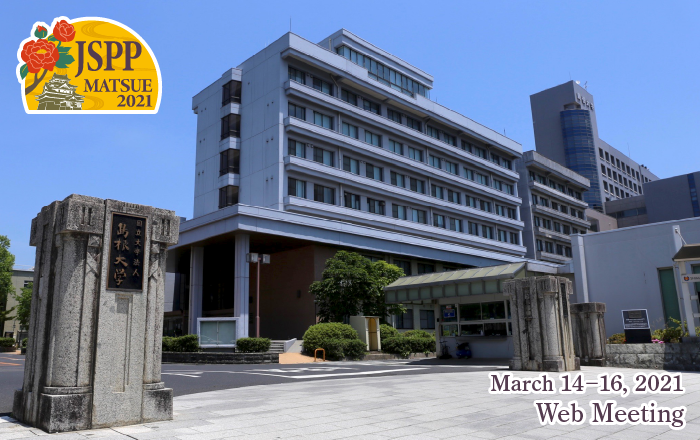The 62nd Annual Meeting of The Japanese Society of Plant Physiologists
March 14-16, 2021 Web Meeting
Logo design “The Blooming Peonies in Matsue" by Oshima-Yamada Yui
A design of many peonies, from buds to large flowers, bloom in Matsue Castle with a wish for further development of research.
Outline
Symposia
◆01 Toward understanding emergence of order in Plant-Microbe Holobiont
Date: 9:30-12:30, March 14 (Sunday), 2021
Venue: Room X
Organizers: Kei Hiruma (The University of Tokyo), Shunsuke Miyashima (NAIST), Akira Mine (Ritsumeikan University), Hironori Fujita (National Institure for Basic Biology)
Plants and their associated microbes have been interacting with each other, forming a collective assemblage of species called “holobiont.” For understanding the mechanisms of plant adaptations to various environmental stress conditions, we need to understand how plant–microbe holobiont is established and impacts host growth and health. In this symposium, based on the talks by various researchers who study different host interactions with microbes, including insect–microbe interactions in guts, we would like to discuss the similarities and differences of emergence of order in various host–microbe holobiont.
Stomatal movements in the assembly of plant-bacteria holobiont
Root cap controls the dynamic of soil microbes by integrating its cell morphogenesis and defense system
Evolutionary Dynamics of Nitrogen Fixation in the Legume–Rhizobia Symbiosis
RNA-Seq reveales virus diversity and the plant-virus interaction in the fields
Genetic and molecular bases of insect gut symbiosis
A role of fungal-bacterial synthetic community for plant growth under nutrient limiting Conditions
◆02 The universality and diversity of stem cell regulation revealed from the study of basal plants
Date: 9:30-12:25, March 14 (Sunday), 2021
Venue: Room Y
Organizers: Kimitsune Ishizaki (Kobe University), Tomomichi Fujita (Hokkaido University)
Plant stem cells are maintained in various places in an individual or regenerated by reprogramming somatic cells to support the sustainable organ growth and propagation of plants. Regarding the molecular mechanisms of stem cell regulation, many studies have been conducted mainly on angiosperms. In recent years, molecular-level and state-of-the-art anatomical studies of stem cell regulation have progressed also in basal land plants, i.e. bryophytes and lycophytes, and interesting findings have provide clues to understand the origin and evolution of plant stem cells. In this symposium, we will focus on recent stem cell research in basal land plants, and discuss the universality and diversity of plant stem cell control from various perspectives. This symposium is sponsored by Grant-in-Aid for Scientific Research on Innovative Areas: Principles of pluripotent stem cells underlying plant vitality.
Stem cells in the basal land plants
Asymmetric cell division in protonemal apical stem cells in the moss, Physcomitrium patens
Discovery of the cellular reprogramming triggered by DNA damage
Cutting untangled a knot between stem cell formation and auxin in Marchantia polymorpha
Exploring the common mechanisms for stem cell propagation from vegetative reproduction of Marchantia polymorpha
Diversity of RAM organization and cell division dynamics in the extant lycophytes
◆03 Frontiers of Plant Genome Editing to shape the future with new technologies
Date: 14:00-17:00, March 14 (Sunday), 2021
Venue: Room X
Organizers: Yuriko Osakabe (Fac. of Biosci. & Bioindust., Tokushima Univ.)
Genome editing technology, which has been rapidly developing in recent years, has not only brought great progress in plant genetic engineering, but is also expected to be further applied to various fields such as medicine, agriculture, and industry. In particular, it has been proposed to play an important role in promoting bioeconomy through integrating with information science and technology. In this symposium, researchers in Japan who are leading the latest plant genome editing technology will gather together to introduce their unique latest researches and review the current breakthroughs. We will discuss how genome editing can contribute to plant science with the latest research results, as well as basic researches, and new issues for the future of plant biotechnology in industry and agriculture.
Development of genome engineering using a novel genome editing tool, TiD
FnCas12a-mediated targeted mutagenesis using crRNA with altered target length in rice
Targeted sequence disruptions of plant mitochondria genomes.
Genome editing by direct delivery of CRISPR/Cas9 components into plant zygote
Development of a cultivar-independent gene editing system in plants
Generation of new technologies of genome editing and plant regeneration
◆04 Re-optimization of Energy Transduction in Photosynthesis — Structure, Function and System
Date: 14:00-16:45, March 14 (Sunday), 2021
Venue: Room Y
Organizers: Jun Minagawa (NIBB), Genji Kurisu (Inst. Prot. Res., Osaka Univ.)
In order to improve the photosynthetic function, it is necessary to understand the detailed mechanism by which the photosynthetic system adjusts the balance between "efficiency of light energy utilization" and "protection from excess light stress" depending on the environment, and to develop a strategy to re-optimize the light energy conversion function of the photosynthetic system. In this symposium, we will discuss the strategy to re-optimize the light energy conversion system by focusing on the mechanisms that control the proton motive force and the mechanisms that are controlled by the proton motive force. The symposium will introduce the latest research on photosynthesis from a wide range of viewpoints, from the molecular level to the system level, focusing on the research results have been promoted in a Scientific Research on Innovative Areas "New Photosynthesis".
This symposium is Jointly sponsored by the Scientific Research on Innovative Areas : New Photosynthesis: Re-optimization of the Solar Energy Conversion System.
Functional and structural analyses of photosynthetic pigment-protein complexes ~Insights into evolution of oxyphototrophs~
Multimeric and monomeric PSII supercomplexes represent structural adaptations to low- and high-light conditions
Systemsbiology of Photosynthetic Organisms
Structural basis for the membrane protein complexes responsible for the formation of proton motive force
Thylakoid membrane remodeling mediated by VIPP1 protein in photosynthetic organisms
Single molecule observation of photosynthetic proteins in thylakoid membrane by high-speed atomic force microscopy
◆05 Mineral element transport systems in plants: transporters, regulation and utilization
Date: 14:00-17:10, March 14 (Sunday), 2021
Venue: Room Z
Organizers: Jian Feng Ma (Institute of Plant Science and Resources, Okayama University), Yi-Fang Tsay (Institute of Molecular Biology, Academia Sinica)
Plants only requires mineral elements for their growth and development. During last decade, a number of transporters for mineral elements have been identified and their regulation has been investigated. Furthermore, some transporters have been manipulated to improve crop productivity and quality. At this symposium, recent progress on identification, regulation, and application of the transporters will be introduced as well as future prospective.
Molecular Basis Underlying Long-distance Movement of Arabidopsis miR399 in Regulating Phosphate Homeostasis
Molecular regulatory mechanisms of phosphate uptake and translocation in rice
Transporters for loading mineral elements to rice grains
Boron-dependent translation of a boron transporter and control of boron requirement in Arabidopsis thaliana
Multilayered regulation of the root iron uptake machinery in Arabidopsis
Improving nitrogen utilization by manipulating nitrate remobilization in plants
◆06 Frontiers in plant redox biology: Redox regulation, oxidative stress and signaling
Date: 9:00-12:00, March 15 (Monday), 2021
Venue: Room X
Organizers: Takanori Maruta (Fac. Life Environ. Sci., Shimane Univ.), Keisuke Yoshida (Lab. Chem. Life Sci., Tokyo Tech.)
Cellular redox changes not only trigger oxidative stress and but also play a key role in the regulation of metabolic and signaling pathways. Redox system is thus critical for controlling a wide array of physiological processes, including stress acclimation, growth and development. In this symposium, we will share the latest progress in the field of redox research, especially focusing on photosynthesis, reactive oxygen species, ascorbate, thioredoxin, and NADPH oxidase. Based on the talks, new perspectives of plant redox biology will be discussed.
Why and how do plants accumulate ascorbate at very high levels?
Evolutionary history of redox regulation in photosynthetic electron transport
Redox regulation of photosystem I: identification of a new FeS protein involved in P700 oxidation
Strong-light response of photosynthesis and redox regulation of protein synthesis
Thioredoxin-based redox-regulatory network in chloroplasts
The role of receptor-like kinase in ROS signaling via NADPH oxidase in Arabidopsis
◆07 A new perspective for integrated Bio-metal Science
Date: 9:00-12:05, March 15 (Monday), 2021
Venue: Room Y
Organizers: Junpei Takano (Grad. Sch. Life Environ. Sci., Osaka Pref. Univ.), Ryo Tabata (Grad. Sch. Bioagri. Sci., Nagoya Univ.)
Organisms including plants require metals and metalloids (defined as “biometal”) for development, growth, and maintenance of activities. Therefore, it is fundamentally important to understand how organisms acquire, transport, and utilize biometals using sensors, transporters, and metal proteins. In this symposium, based on the recent progresses in the field of plant biology, mammalian cell biology, mathematical modeling, and chemistry, new perspectives of Bio-metal science will be discussed. This symposium is supported by a grant-in-aid for scientific research on innovative areas “Integrated Bio-metal Science”.
Systemic regulation of iron acquisition in plants
Plant iron deficiency responses and iron sensing by iron- and zinc-binding HRZ ubiquitin ligases
Crosstalk of zinc homeostasis and protein quality control in the secretory pathway of mammalian cells
Contribution of Sulfur Assimilation and Metabolism to Metal Uptake and Accumulation in Plants
Predicting the dynamics of bio-metals by transport simulations
BOR1 is a borate transceptor.
Characterization of metal-associated proteins by conditional proteomics approach
◆08 Past and future of plant RNA research answering fundamental questions
Date: 9:00-11:55, March 15 (Monday), 2021
Venue: Room Z
Organizers: Masayuki Tsuzuki (Grad. Sch. Arts. Sci., Univ. Tokyo), Yukio Kurihara (RIKEN CSRS)
Plant RNA biology has generated and addressed the fundamental biological questions, since RNAs play pivotal roles in gene expression, therefore, RNAs can provide insights into the diversity and commonality of the biological processes among wide ranges of organisms. In this symposium, we aim to overview how plant RNA biology has progressed, as well as to discuss how it should be further developed. To this end, we invite a world leader in the field of plant RNA research, mid-career researchers who are currently active in the field, and young researchers who will lead the future of the field as speakers, for the active discussion on the "past" and "future" of plant RNA research.
Broad Noncoding Transcription by RNA Polymerase V Suggesting Genome Surveillance
Biochemical characterization of Dicers in plants and other eukaryotes
Deadenylases in the Arabidopsis CCR4-NOT complex act in shoot regeneration from the callus
Early origin of synchronization between chloroplast translation and cytosolic mRNA abundance in plants
tRNA wobble uridine modification in Arabidopsis thaliana
Translation Arrest and mRNA Degradation: What We Could See/ yet Cannot See from Methionine Biosynthesis
◆09 Molecular elucidation of plant environmental adaptation toward engineering responses of field-grown plants
Date: 13:00-15:50, March 15 (Monday), 2021
Venue: Room X
Organizers: Akira Mine (Col. Life Sci., Ritsumeikan Univ.), Kohji Yamada (Grad. Sch. Tech. Ind. Sco. Sci. Tokushima Univ.), Kaori Yoneyama (Grad. Sch. of Agric., Ehime univ.)
As sessile organisms, plants need to adapt to changes in diverse environmental factors, which include not only abiotic factors such as day length and soil water availability but also biotic factors such as invading microbes. In addition, as being comprised of multiple organs with different physiological roles, plants need to coordinate their environmental responses in different organs via systemic signaling. In this symposium, the researchers in the PRESTO research area “Control of Field-Grown Plants Phenomena” will present their research progresses toward elucidating the mechanisms that enable plants to adapt to diverse environments. Based on our achievements, we would like to discuss future directions for engineering environmental responses of field-grown plants.
Supra-organismal regulation of strigolactone synthesis and exudation in response to rhizospheric cues
Root anatomical traits that correlate with environmental adaptation of plants
Long-distance mobile peptides maintain root sucrose level and root growth
A molecular mechanism of defense-sugar crosstalk
Epigenome regulation of environmental adaptations in plants
Diverse non-coding RNAs involved in plant reproductive system
◆10 Borderless Era of Plant Chemical Research —New Trends in Plant Chemical Biology and Plant Metabolite Chemistry.
Date: 13:00-16:00, March 15 (Monday), 2021
Venue: Room Y
Organizers: Takeshi Nakano (Kyoto Univ.), Masami Hirai (RIKEN)
As plants are photosynthetic organisms that can produce natural organic compounds by themselves, plants have been synthesizing approximately one million kinds of low molecular weight compounds for regulation of plant life. In these compounds, bioactive compounds that have effects from out of plant cell itself have been analyzed by chemical biology and chemicals that are synthesized in plant cell itself have been analyzed by metabolomics.
These plant-based natural organic compounds and synthetic organic compounds will be considered to connect to and affect each other in the way that is similar to ‘inter-connected through service’ of urban traffic system in many aspects of compounds themselves, biosynthetic pathway, signaling and physiology.
In this symposium, by mixing of researchers who are standing on plant chemical biology and/or plant metabolic chemistry, biological significance of these plant organic compounds for the organism itself and grovel ecosystem will be discussed. Furthermore, new technology to contribute developments of sustainable society based on these chemical knowledges will also be explored.
Identification of structures and functions of widely spreading acylspermidines
Reconsideration of amino acid metabolism in plant —from the viewpoint of development—
Development and utilization of synthetic compounds for elucidation of physiological function of abscisic acid receptors.
Exploiting the metabolic polymorphism of polyphenolics in plant species
Chemical biology to reveal molecular mechanism of plant growth
Functions of plant chemicals in the rhizosphere and possibilities for plant growth regulation
How did licorice acquire the ability to produce a sweet saponin?
Construction of a data resource for the top-down discovery of unused plant-derived specialized metabolites
◆11 Elongate, bend, and expand: Deciphering plant growth strategy from its mechanics
Date: 9:00-11:50, March 16 (Tuseday), 2021
Venue: Room X
Organizers: Yuki Yoshida (Kumamoto University), Misato Ohtani (The University of Tokyo)
Living organisms around us show a rich diversity in their body size,
ranging from invisible minuscule to overwhelming hugeness. Remarkably in plants, de novo organogenesis in response to endogenous growth and external cues generally occurs, which results not only in size change but also shape complexification during their lifetime. How do plants know and adjust their effective growth strategy, according to their size scale, to achieve an optimal body system under a given environment? In this symposium, we invite six young speakers studying the newest topics on the mechanical aspects of plant shape and growth. We aim to promote a multifaceted discussion towards
understanding of a new layer of plant growth strategy. This symposium is co-organized by MEXT Grant‐in‐Aid for Scientific Research on Innovative Areas, "Plant Structure Optimization".
Plant plasticity through the narrow gate
The strategy of plant survival revealed by nutritropism in rice roots.
A mechanical criterion for root-penetration into soil based on root-soil mechanics
How to make a shelter in the shape of an egg, learn from testate amoeba
Growth stress of large-diameter trees
Plant Physics: its Diversity and Universality
◆12 Molecular Mechanisms of Transcriptional Repression in Plants
Date: 9:00-12:00, March 16 (Tuseday), 2021
Venue: Room Y
Organizers: Hironori Takasaki (Saitama Univ.), Masaru Ohme-Takagi (Saitama Univ.)
The regulatory system of gene expression is essential for the control of activities of living organisms. General transcriptional and various regulation systems appropriately control switching genes ON and OFF during the environmental adaptation and developmental processes. The molecular mechanisms of repression of transcription were analysed and the histone modification, DNA methylation and transcriptional repressors, which modify cis-acting region in the genome, were shown to act as negative regulators of transcription playing a key role in the regulation of gene expression. Various combination of each transcriptional repression system regulates gene expression of multiple genes through composing a regulatory network together with the transcriptional activation system. Recent advances have revealed various biological roles of complex transcriptional regulatory mechanisms and evolutional conservation, such as complex histone modifications during seed germination, transcription factors that regulate embryogenesis and histone modifications during the endosperm developmental processes of rice. In this symposium, we will introduce the current studies by front runners who are studying these topics in various plant species and with different approaches. The subjects to be revealed in this research area are to be discussed.
Combinations of maternal-specific repressive epigenetic marks in the endosperm control seed dormancy
Functional analysis of ELONGATION OF SILIQUES WITHOUT POLLINATION 3 in endosperm in Arabidopsis
The factor of transcriptional repression regulating endosperm development in rice
Semi-automatic transient gene expression system in plant protoplast for plant TFome analysis.
Transcriptional silencing of the cold-inducible DREB1A/CBF3 gene in the Arabidopsis ice1-1 mutant
Transcriptional repression wakes up green algae
◆The 17th Database Workshop
Date: 9:30-12:30, March 14 (Sunday), 2021
Venue: Room Z
Organizers: Kentaro Yano (Sch. of Agri., Meiji Univ.), Shizuka Koshimizu (Sch. of Agri., Meiji Univ.)
In the 17th Database workshop, we will focus on the databases and machine learning methods for largescale omics data in plant science. It is still difficult to efficiently identify the key factors contributing to a biological process by analyzing omics data with bioinformatics approaches. Here, the powerful approach and databases storing high-quality omics data and knowledge-based functional annotations, obtained by the natural language processing (NLP) technology, will be introduced. The deep learning methods will be also discussed for the image data. Automatic annotation software can be applied to the generated large amount of images, however, it is not avoidable to annotate with manual hand works due to correcting machine learning-based annotation errors. The Active Learning method combining manual annotation works and deep learning model constructions are explained. Finally, a Convolutional Neural Network (CNN) approaches will be discussed. Although relevance of the diagnosis by CNN (to say, “why did you say that” in CNN) had been in a black box in conventional technologies, recent methods for network backpropagation, so called “explainable AIs” allow for feature visualization of the diagnosis by CNN. User-friendly applications of deep learning image/DNA sequences diagnosis will be introduced, too.
Co-sponsored by MEXT KAKENHI "Determining principles in the birth of new plant species"
Introduction
How to Accelerate Image Annotation Hand Works and Active Learning for Plant Phenotyping Analysis
Human vs. AI?: deep learning frameworks spot specific physiological reactions and genomic patterns in plants



